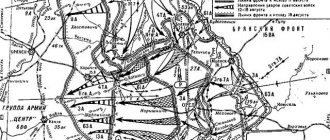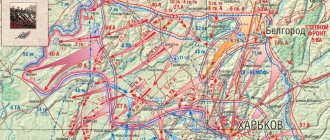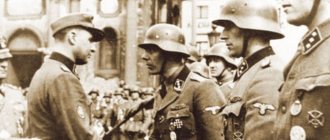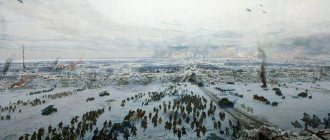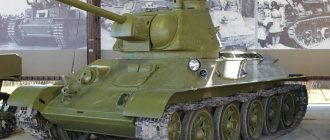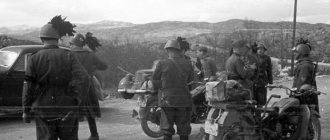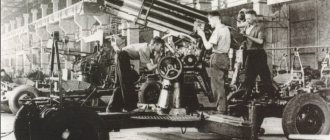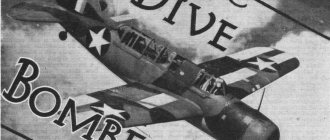Ostrogozh-Rossoshan offensive operation
Here is the work presented in the category “History of my small homeland” of the competition “Heritage of Ancestors to the Young” 2022. Author - Svetlana Fedotova (village of the 2nd department of the Pobeda state farm, Ostrogozhsky district). More information about the competition: https://vk.com/vrn_nasledie
1. The situation of the Soviet Army.
The war against the USSR was considered by the Nazis as a war of extermination, the result of which was supposed to be racial genocide. Hitler considered the Russian people to be “subhumans,” and their existence was justified only from an economic point of view, that is, Russians could only be slaves. His plans included the complete destruction of our people. When planning the war, the German command counted on short-term military action. Hitler wanted to make the territory of the USSR a raw material base for the German Reich, so that he could later conquer England and the USA.
But having invaded the USSR, the Nazis learned that this was not just an attractive territory, but a country, a people that would spare nothing to protect its land and its inhabitants. Having quite serious losses in the first stage of the war, Soviet troops were still able to thwart the Nazi plans for a short war. As a result of the counter-offensive near Moscow, with the support of their people and the help of their allies (the USA), the Nazis’ confidence in victory in World War II was destroyed. To continue military operations, Hitler needed new energy resources, and he decided to move his activities to the south. With an offensive to the south of the country, he hoped to seize the initiative to wage war into his own hands. The main allies of the fascists were Italy and Japan, who hoped for a new division of the world and strengthening their position in the post-war period.
In the spring of 1942, the Soviet command was preparing a plan for the spring-summer campaign. Stalin, having information that Germany’s losses were very significant, and the Soviet army, although it suffered losses in the form of valuable personnel, had better equipment. By the spring of 1942, the USSR had more than 400 divisions, 11 million. soldiers and officers, over 10 thousand tanks, and more than 11 thousand aircraft. However, the new recruits had no idea about military training and technical equipment was still small. Stalin was confident in the victory of his positions, based on the results of the winter battles. And he believed that in 1942 the main enemy forces would be defeated. It was believed that the Germans would attack in two directions: central and southwestern. The main strike was supposed to be on Moscow, and the strike aimed at the North Caucasus would be of a secondary nature. Some of the military leaders believed that in the current situation it was necessary to move to strategic defense (Marshal B.M. Shaposhnikov). Stalin did not “want to sit and wait for the enemy to strike,” did not accept the very concept of defense, and considered it unworthy of the Red Army. It was possible to accept Zhukov’s proposal for an offensive with the goal of defeating the Rzhev-Vyazma group of Germans. A decision was also made on an offensive movement in the areas of Leningrad, Demyansk, Orel and Crimea. The situation that developed on the Soviet-German front in May-June 1942 turned out to be extremely difficult for the Soviet troops. The attempt to liberate besieged Leningrad was defeated. Our Army suffered significant losses in Crimea and near Kharkov.
By mid-June, the balance of forces in the south was in favor of the Nazis, and the German command began to develop a new plan for the offensive movement, it was called “Blau”. The 2nd field and 4th tank German armies were supposed to launch an offensive on Voronezh, and the 6th field on Ostrogozhsk. Upon reaching Voronezh, the 2nd and 4th Armies were to strike at Kantemirovka, where they would be joined by the 1st Tank Army. The Germans wanted to defeat the troops of the Southwestern Front. And then move to Stalingrad and the Caucasus. As a result of the destruction of the German plane, information about the upcoming Operation Blau fell into the hands of the Soviet command. Stalin ignored the information received and was confident that the enemy would strike Moscow. As a result, the necessary measures were not taken to strengthen the vulnerable borders.
The German command decided not to change plans, but to strike as quickly as possible, which began on June 28, 1942. Attempts by the headquarters to organize a counterattack were unsuccessful. Chief of the General Staff A.M. Vasilevsky wrote that the defense at the junction of the Bryansk and Southwestern fronts was broken through to a depth of 80 kilometers, and the enemy strike force threatened to break through to the Don and capture Voronezh. July 4, 1942 German troops reached the approaches to Voronezh, and on July 6 they crossed the Don and captured part of the city. But they failed to capture the entire city. The position of the Soviet troops continued to deteriorate. The Hungarians and Italians came to the aid of the Germans. Since October 1942, there was a temporary lull on the Soviet-German front.
The leadership of Nazi Germany attached particular importance to propaganda among Russian military personnel and the civilian population. The disintegration of enemy troops, a decrease in morale, and stimulation of support for the occupation regime among the inhabitants of the occupied areas were considered by the Nazis as necessary means to maintain power in Europe. The main document for carrying out propaganda was the directive signed by General A. Jodl in June 1941, “Instruction on the use of propaganda according to the “Barbadoss” option.” The main goals of this document were: undermining the authority of the USSR, a positive image of captivity, increasing dissatisfaction among the civilian population with the situation in the country. The main means of propaganda was printed materials: leaflets, various brochures.
After the completion of Operation Blau, the strike groups of German troops moved south. The German command attached particular importance to holding the defensive line on the Don River. Troops of generals F.I. Golikov and N.F. Vatutin held the defense on the eastern bank of the Don. During July-September 1942, the troops of the Voronezh Front conducted active military operations, holding back the enemy and preventing him from moving to Stalingrad - at that time there were fierce battles there. It was these military actions that became the turning point in the Great Patriotic War and the Second World War. Headquarters developed new plans for the liberation of Voronezh. Several planned operations remained unfinished. The main successful result of the summer battles was the capture and retention of bridgeheads on the right bank of the Don. This event played an important role during the Ostrogozhsk-Rososhansk offensive operation.
2.Planning the operation.
As a result of the counter-offensive of the Soviet Army near Stalingrad, the headquarters of the German 6th Field Army, 5 German corps, 2 Romanian divisions, and numerous rear units were surrounded - up to 160 separate units in total. The number of encircled enemy troops exceeded 280 thousand people. Major General K.S. Moskalenko, a plan was developed, the purpose of which was to recapture a section of the Voronezh-Rostov railway from the station. Freedom to Millerovo, for this it was necessary to strike at Kantemirovka, Ostrogozhsk and Rossosh. Stalin approved the new plan. By order of Stalin, G.K. arrived at the army command post. Zhukov, and personally inspected the enemy’s defenses. At first he was skeptical about the plan proposed by Moskalenko, but after carefully studying all the nuances, he approved the plan. The start of preparations had to be postponed due to the situation at Stalingrad. And only in December the Headquarters issued a directive on the preparation of the Ostrogozh-Rossoshan offensive operation. The purpose of this operation was: the liberation of the Liski-Kantemirovka railway and the destruction of enemy troops on the Upper Don. This was necessary to do for a further attack on Kursk and Kharkov. The offensive plan was as follows - three strike groups were created: the northern group struck from the Storozhevsky bridgehead in the direction of Boldyrevka, Krasnoye, Alekseevka; part of the forces of the northern group attacked Ostrogozhsk; the southern group - from Kantemirovka to Alekseevka, where it was supposed to connect with the northern one. A strike was planned in the direction of Rossosh and Karpenkovo.
It was planned not only to create internal and external fronts of encirclement, but also to dismember the enemy army into several parts, this should have led to the destruction of the enemy. The Ostrogozhsk-Rossoshan operation was supposed to become a new word in the development of the theory and practice of conducting offensive operations. Six future Marshals of the Soviet Union took part in the development of this operation. Preparation for the operation consisted of the transfer of troops allocated by Headquarters and the regrouping of existing ones. They tried to carry out such large-scale actions as unnoticeably as possible. Therefore, the goal of our fighters was to misinform the enemy, to create the appearance that the strikes would be carried out on the wrong sectors of the front.
The winter of 1942-1943 was snowy, and the lack of railway lines made the movement of troops difficult. Therefore, the local population was organized to clear the roads. Advancement to the destination was difficult: they moved at night, over long distances, carrying materiel with them on sleds. The army was specially trained to fight in winter conditions. For the secrecy of the impending operation, the ongoing political information played a major role. But the enemy could not be underestimated; reconnaissance could detect movements on the Soviet front and strike at those areas that were weakened. It was also necessary to strengthen the flanks; counterattacks at the bases of the wedges were one of the Germans’ favorite methods. This led to the fact that Soviet troops often found themselves surrounded. A number of measures have been taken to prevent this. Actions were taken to mislead the German enemy: railway stations on passive sectors of the front were cleared, repair tanks were transported and unloaded, one-time offensive actions were carried out, and others. All these measures had their effect, and the Nazis expected the main blow from the area of Liski and Pavlovsk.
One of the important conditions for a successful offensive, surprise, was fulfilled during the preparation of the Ostrogozhsk-Rososhan operation. The start of the operation was originally planned for January 12, but due to some difficulties it was postponed to January 14. There were problems with material support. The air force was quite weak. To strengthen their positions, the Soviet command had to remove all guns and mortars from passive sectors of the front; such a step was very risky. One of the important means of a successful breakthrough was the presence of tanks. Therefore, most of the available tanks on the Voronezh Front were used to carry out the operation.
It became known that the Germans suffered serious losses after the defeat at Stalingrad and the Middle Don. And to replenish their army, they resorted to mobilizing the population in the territories they occupied. These were both Poles and Ukrainians.
All the shortcomings could not be corrected a few days before the attack. There was a shortage of weapons and fuel. There was no proper level of military training. All this could only be compensated by the high morale of the soldiers. For this purpose, various events were held, rallies and conversations were held in military units. Political work was also carried out with the local population: leaflets were printed saying that the defeat of the German yoke was near, that those who left with the Nazis would be in eternal slavery, that they had nothing to fear from Soviet power, that the Red Army was advancing and after the war a new joyful life would begin life in our native land!
3. Ostrogozhsk - Rossoshan offensive operation.
Two days before the start of the operation, it was necessary to carry out reconnaissance in force in order to know more about the location of the enemy. The Germans' tactics were as follows: they carefully camouflaged the front line of defense. And in order not to waste ammunition, it was necessary to have more specific information about your enemy. On the eve of the operation, Soviet soldiers took actions to neutralize the enemy, identify the exact front line of defense, German and Hungarian soldiers were destroyed and captured. Hungarian prisoners said that the German command hid what the real situation was. And if they had known that things were so bad for the Germans, they would have all scattered long ago. The Hungarian army was not ready for the frosty Russian winter. There was not enough warm clothing, there was little food.
The tactical success achieved on January 12 posed a question to the command: should we wait for January 14 (the date scheduled for the offensive), or should we start the offensive now? It was decided not to wait, and on January 13, aviation began bombing enemy headquarters and attacking its front line. Soviet troops destroyed enemy aircraft, troop concentrations and other enemy technical equipment.
With their fire, the artillerymen and mortarmen partially paralyzed the enemy, thereby forcing them to conduct the battle in a disorderly manner. This situation helped prevent the appearance of the main enemy forces at the front line. And by 10.00 the first line of Hungarian defense was broken through. The command was able to introduce fresh forces into the breakthrough and paralyze the enemy forces. On January 12-13, Soviet soldiers managed to fulfill the plan planned for the first day of the offensive: Uryv was liberated, the enemy group defending the northwestern part of Uryv was destroyed, the enemy was captured, and they captured height 178.1. The invaders tried to hold Boldyrevka, but they failed, and she was released. A large number of Russian soldiers distinguished themselves in the first days of the offensive. They fought bravely for every inch of their native land. They boldly rushed into the attack, which confused the enemy army. In the village of Devitsa, the Germans had a strongly fortified stronghold. During the battle, our defenders managed to liberate part of the village. The enemy was finally driven out of Devitsa on the night of January 14, and the Kalinin farmstead was liberated at the same time. On the morning of January 14, the division headquarters moved to Devitsa.
Things weren't going so well on the right flank. Due to weather conditions, the Hungarian fire system was not completely suppressed. And only by lunchtime we managed to capture height 185.6, which played a big role in the enemy’s defense system. In the battle for Dolgalevka, Soviet soldiers faced stubborn resistance. The battle was fierce. It was decided to postpone the attack for the night. In this village the Germans had the headquarters of a heavy artillery regiment and German reserve units. Having liberated Dolgalevka, we broke through the enemy’s tactical defense zone. Thus, on the first day, the defense line of the 2nd Hungarian Army was broken through in several areas. The enemy's morale has dropped!
The next day, January 14, all strike groups of the Voronezh Front went on the offensive. The main task was to prevent the enemy from creating a new line of defense. On the night of January 15, a battle broke out for the village of Arkhangelskoye, but the enemy retreated and left warehouses with ammunition and food. The breakthrough of our troops along the planned path continued. On January 15, 20 more settlements were liberated by units of the 40th Army. To destroy the enemy's morale, political agencies printed leaflets that were dropped from an airplane among enemy troops.
The destruction of the 2nd Hungarian Army continued. The German command, guided by Hitler's orders, did not give a decision to retreat, although the army command saw the need for this. People died from cold, hunger and the advance of Russian troops.
After breaking through the Hungarian defense, units of the 40th Army developed an offensive with units of the 18th Rifle Corps and the 3rd Tank Army to create internal and external fronts to encircle the Ostrogozh-Rossoshan enemy group. The left-flank formations advanced to Ostrogozhsk and Alekseevka, and the right-flank formations to the north and northwest, providing protection from the counterattack of the 2nd German Army from the Voronezh region.
After breaking through the second line of Hungarian defense, the 25th Infantry Division began an offensive in a westerly direction. The settlements of Skoritskoye, Lyagushevka, Fabritskoye, Krasnolipye, Repyevka and others were liberated. And everywhere the liberators were greeted joyfully. People had to endure a lot of pain and suffering. The Nazis mocked the wounded, killed, burned and staged show executions of civilians.
Messages from the Sovinformburo that: the advance of Russian troops in the southern direction was successful, the village was liberated. Korotoyak and many settlements were reported to all soldiers and commanders. The morale of the soldiers increased in every possible way. On the night of January 18-19, Soviet troops stormed the western outskirts of Ostrogozhsk. This city was important for the enemy, as it was located on the railway line going to Valuiki. And also nearby were the roads to the south along which the enemy was planning to withdraw his troops. Soviet troops liberated Alekseevka, Valuiki, Kamenka, as a result of which the enemy was trapped in a ring. By the evening of January 20, the 107th Rifle Division completely captured Ostrogozhsk.
The result of the first seven days of the offensive was: the complete defeat of the 9th, 6th, 20th, 7th, 13th and 10th Infantry Divisions of the Hungarians and the 168th Infantry Division of the Germans. This was the collapse of the 2nd Hungarian Army on the Don; the remnants of the army began a disorderly retreat in forty-degree frost. They had neither food nor warm clothing.
The task of the 18th Rifle Corps was to break through the enemy’s defenses - the 7th Army Corps of the 2nd Hungarian Army and advance in the western, southwestern and southern directions, and connect with the 40th and 3rd Tank Army. It was decided to carry out the breakthrough from the Shchuchensky bridgehead through the positions of the Italian corps. On January 14 at eight o'clock in the morning the offensive began. The enemy again had to verify Russian power, strength and fury. The battle lasted for 2 hours. The Germans and Magyars were scared to death, they surrendered and retreated.
In the occupied settlements, the Nazis established their own rules: they raped women, took food and clothing from civilians. Livestock was stolen and crops were destroyed. They were forced to work, and for not going to work they were severely punished. During the first 2 days of the offensive, units of the 18th Rifle Corps advanced 25 km.
According to the plan of the Ostrogozhsk-Rososhansky operation, the 3rd Tank Army was supposed to strike from Kantemirovka in the north-west direction, with the aim of connecting with units of the 40th Army and encircling the enemy. It was necessary to strike in the general direction through Rossosh, Olkhovatka to Alekseevka and in the northern direction to Kamenka, in cooperation with units of the 40th and 6th armies, to encircle and destroy the Rossoshansko-Pavlovsko-Alekseevskaya group of the enemy. Liberate the Liski-Kantemirovka and Liski-Valuiki railways. The offensive was successful, the Russian soldiers, inspired by their small victories, fought desperately. The enemy began to retreat in a northern and northwestern direction; he was scared, angry, and cruel. Soviet troops reached Lizinovka, liberating the occupied territories. Now they were faced with the task of capturing Rossosh and Olkhovatka. It was necessary to block the highways Rossosh - Arkhipovka, Rossosh - Shaposhnikovo and cut off the retreat routes for the invaders to Olkhovatka.
Shortly before the liberation of Rossosh, the Italian soldiers were confident of victory, they wrote reassuring letters home and expected that all this would soon end. The Italian troops had outdated uniforms; when they arrived at the Soviet-German front, they felt hatred from the Russian population and contempt from the Germans. They were poorly fed, there were not enough weapons and equipment. And they themselves said that they could not wage such a war. The Alpine Italians were accustomed to slow battles in the mountains, but in the steppe they were lost.
The liberation of Rossoshi continued until 24.00 on January 16. The enemy did not want to give up positions and put up fierce resistance. Immediately, a military commandant’s office began working in the city, and traitors and traitors began to be identified. As a result of the liberation of Valuyki and Urazovo, the enemy command lost the opportunity to control its troops along the Kastornoye-Valuyki railway section. On January 18-19, 1943, the Ostrogozh-Rossoshan enemy group of up to 13 German, Hungarian and Italian divisions found themselves surrounded. The destruction of the encircled enemy took place simultaneously with the redeployment of troops of the Voronezh Front for the upcoming Voronezh-Kastornenskaya and Kharkov offensive operations. Partisan detachments made a great contribution to the liberation of our country.
4. Meaning and results.
The Ostrogozhsko-Rossoshansk operation lasted 15 days. During these 15 days, the Red Army surrounded and destroyed the enemy group on the Don between Voronezh and Kantemirovka. Soviet troops completely destroyed 14 enemy infantry divisions, the German Vogelein divisional group, and the 700th German brigade. Six infantry and one tank divisions suffered heavy defeats. By January 23, 1943, Soviet troops captured 71,450 prisoners and destroyed up to 52,000 enemy soldiers and officers. The total number of those in Russian captivity was 86,000 enemy soldiers and officers during the Ostrogozh-Rososhansk operation alone. Many trophies were captured: various weapons, tanks, cars and other provisions.
The Ostrogozhsk-Rossoshan operation became a huge contribution to the development of military affairs. The troops of the Voronezh Front simultaneously launched an offensive in three directions. This was the first time during the Great Patriotic War that one front, having an unfavorable balance of forces, made a breakthrough in three directions. Under the conditions of this operation, for the first time, a reinforced rifle corps advanced in a separate direction, performing the role of one of the strike groups, between the two main ones. During the Ostrogozhsk-Rososhansky operation, valuable experience in attacking from bridgeheads was acquired.
One of the differences from the offensive operations carried out in 1941-1942 was that a characteristic moment in the development of tactics was the conduct of reconnaissance in force. The forward battalions were supported by tanks, artillery and aircraft. Another innovation was that the dismemberment and destruction of the enemy was carried out simultaneously with the encirclement.
At the start of the offensive operation, the troops of the Voronezh Front did not have superiority in strength, but thanks to skillful command they were able to reorganize in a short time and strengthen the necessary directions at the expense of secondary sectors. And this was very risky. The success of the Ostrogozhsk-Rososhansky operation was due to the high rate of advance of the front troops, which required high moral and physical effort from them during the operation.
Military historian V.P. Morozov highly appreciated the significance of this operation. He saw an inextricable connection between the Battle of Stalingrad and the Ostrogozh-Rososhan operation. It was this that, in his opinion, became the standard for all subsequent offensive operations.
Literature:
- “Ostrogozh-Rossoshan operation – “Stalingrad on the upper Don” - S.I. Filonenko, A.S. Filonenko. — 2nd ed., rev. and additional – Voronezh: Kvarta, 2005. – 416 p.;
- https://istorya.ru/book/roo/04.php;
- https://pokrov3.narod.ru/oper.html;
- https://militera.lib.ru/h/sb_vi_9/15.html.
presentation on the topic “Ostrogozhsk-Rosshansky operation” presentation for a history lesson on the topic
Slide 1
The winner is overshadowed by the blazing Victory banner, A tired soldier sat down on the steps of the Reichstag. He took off his cap, like a worker after work, wiping drops of hot sweat from his forehead. He put down the machine gun, shook off the dust from his tunic, poured a pinch of shag from the pouch... I looked again, How our banner shines over the enemy’s capital in the spring wind, rolled up a cigarette, took a drag on calmly and said: “This is how any war will end.” Kadir Dayan (9 May 1945)
Slide 2
Objectives and planning of the operation By order of the Supreme Command Headquarters on July 7, 1942, the Voronezh Front was created. However, the plan for the operation to defeat the enemy on the Upper Don matured gradually. Proposals to conduct it came to the Supreme Command Headquarters from the General Staff and the command of the Voronezh Front. The issue of the operation was finally resolved only on December 21, 1942. On this day, the task was set - to prepare and conduct an operation with the aim of defeating enemy troops in the Ostrogozhsk - Kamenka - Rossosh area and clearing the Liski - Kantemirovka and Liski - Valuiki railway sections from them. To do this, the Headquarters strengthened the Voronezh Front, transferring to it from its reserve the 3rd Tank Army, the 7th Cavalry Corps, three rifle divisions with reinforcements, as well as the 4th Tank Corps. In total, in mid-January, the front forces included more than 243 thousand soldiers and officers, about 4 thousand guns and mortars, over 900 tanks and 208 aircraft.
Slide 3
Army General Colonel General G.K. Zhukov A.M. Vasilevsky
Slide 4
Commander, Commander of the 3rd Tank Army of the Voronezh Front, General P. S. Rybalko, Lieutenant General F. I. Golikov
Slide 5
The operation was planned to a depth of 140 km, along the front - 250 km. The pace of the offensive was to be: for rifle formations - 15-20 km, for tank formations - 35 km per day. The command of the Voronezh Front made a bold decision - by weakening secondary sections of the front, create powerful strike groups in the directions of the main attacks. The breakthrough was planned to be carried out in three sections, the width of which ranged from 8-10 to 16 km. The density of artillery in the breakthrough areas reached 102-108-201 guns and mortars, tanks - 11-15-40 units per kilometer of front.
Slide 7
The Ostrogozh-Rossoshan operation began on January 13, 1943 with the battle of the forward battalions in the 1st Storozhevoye area. In general, the army troops achieved significant success during January 13th. Our strike group broke through the main enemy defense line 10 km along the front and in depth, liberating the settlements of Dovgalevka, Boldyrevka, Devitsa. The task of the first day of the operation was almost completely completed. Their success the next day was developed by the main forces of the 40th Army. On January 14, the 3rd Tank Army and the 18th Separate Rifle Corps, as well as the 6th Army of the Southwestern Front, joined the operation. By the end of January 15, the troops of the 40th and 3rd Tank Army broke through the enemy’s defenses to the entire tactical depth and defeated his four divisions.
Slide 8
On January 16, front troops began to cover the Ostrogozh-Rossoshansky enemy group. Two days later, formations of the 40th Tank Army reached the Alekseevka area and completed the encirclement of 13 enemy divisions. At the same time, the 161st Rifle Division and the 192nd Tank Brigade of the 18th Rifle Corps from the north and formations of the 12th Tank Corps of the 3rd Tank Army from the south, with counter attacks in the general direction of Karpenkovo, divided the enemy group into two parts: one (five divisions) was in the Ostrogozhsk-Alekseevka-Karpenkovo area, and the other (8 divisions) was north and northeast of Rossosh, which was cut from the north by the 219th Infantry Division and the 96th Tank Brigade of the 18th Rifle Corps, and from the south by formations of the 12th Tank Corps of the 3rd tank army. From January 19, the ring around the encircled enemy divisions began to shrink. By January 27, the Ostrogozh-Rossoshan enemy group, dismembered into parts [398], was eliminated.
Slide 10
Results By the time the operation was completed, our troops captured 86 thousand enemy soldiers and officers. The enemy lost almost the same number in killed and wounded. The battles to defeat the troops surrounded in the Ostrogozhsk area and northeast of Alekseevka took place on January 19-20. The liquidation of the Rossoshan group continued until January 27. In an offensive operation that lasted 15 days, the troops of the Voronezh Front broke through the enemy’s defenses by 250 kilometers and advanced 140 kilometers in depth. They liberated 3 thousand settlements, the operationally important railway sections of Liski-Kantemirovka and Liski-Valuiki, which created favorable conditions for a further offensive in the Kharkov direction and in the Donbass.
Slide 11
No one is forgotten, nothing is forgotten
